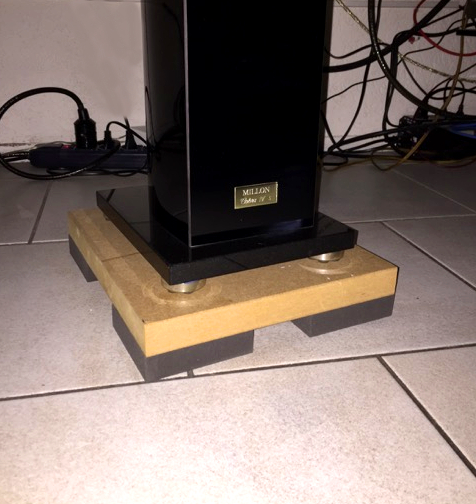Acoustic decoupling of speakers and subwoofers
A well-known sound problem when playing music, at home or in a catering establishment, is the leakage of low frequencies. This has two reasons: contact sound (resonance) from speakers and subwoofers, but even more so the airborne sound (sounds reproduced) from these sound sources. We will help you to find the solution to this noise problem!
Insulating contact noise
In order to reduce contact noise, you need to decouple the speakers from the surface. In the context of a building this surface is the floor, and in your vehicle the bottom plate (bodywork). The transmission of vibration and resonance can be prevented by applying the so-called mass-bounce-method.

This method works as follows: You place the speaker or subwoofer on a heavy foundation (mass), such as a heavy tile that is larger than the speaker cabinet (view photo). The tile, or a beautiful piece of natural stone, is placed on four parts Regufoam (bounce). On the photo you can see the application in practice. In this case a heavy plate has been laid on Regufoam D300. The plate is a bit larger than the speaker, which ensures that the speaker remains stable. This is certainly necessary with column speakers, which have a high centre of gravity.
Parts Regufoam D300 with a thickness of 25 mm are most frequently applied by real audiophiles, usually because of the colour. Ideally, speakers with a low weight are placed on the softer, green Regufoam D150 variant with a thickness of 25 mm.
What do I need to decouple my speakers or subwoofer?
We have drawn up a schedule based on the weight of your speakers:
|
Weight(kg) of the speaker |
Surface of (cm²) Regufoam to be applied per speaker | Quantity to be purchased |
| 10 kg | 100 cm² (or 4 legs of 5 x 5 cm, thickness 5 cm) | 1 x Regufoam 150 | 25 mm (enough for 20 leg of 5 cm thick) |
| 20 kg | 200 cm² (or 4 legs of 7 x 7 cm, thickness 5 cm) | 1 x Regufoam 150 | 25 mm (enough for 12 legs of 5 cm thick) |
| 30 kg | 300 cm² (or 4 legs of 8,7 x 8,7 cm, thickness 5 cm) | 1 x Regufoam 150 | 25 mm (enough for 8 legs of 5 cm thick) |
| +10 kg | +100 cm² |
The size of the Regufoam parts may vary per type of floor and speaker, so you might need to experiment a little. An excellent alternative, bearing the name Audio Dampers Basic, comes in sets that consist of 12 round pre-cut pieces of Regufoam D150, with which you can acoustically decouple multiple speakers but also audio components.
Insulating airborne noise
Most nuisance is caused by airborne noise, the sounds that are produced by the loudspeakers. Even if the person complains about vibration, this is usually the sound pressure resulting from lower frequencies. You can reduce this pressure by installing floating walls, a floating ceiling and / or floor.
The more the 'room-in-room' principle (also called box-in-box principle) is applied, the more sound is kept inside a room. You can make such a wall and ceiling construction by using Merfoflex. A complete floating floor system exists as the product Akoestifloor.
Questions? 
Do you have any questions about this topic? Please feel free to contact us, we will be happy to answer your questions as soon as possible.

 Sound Absorption
Sound Absorption  Sound Insulation
Sound Insulation  Vibration Isolation
Vibration Isolation  Silent Ventilation
Silent Ventilation  Accessories
Accessories  Thermal & Acoustic Insulation
Thermal & Acoustic Insulation